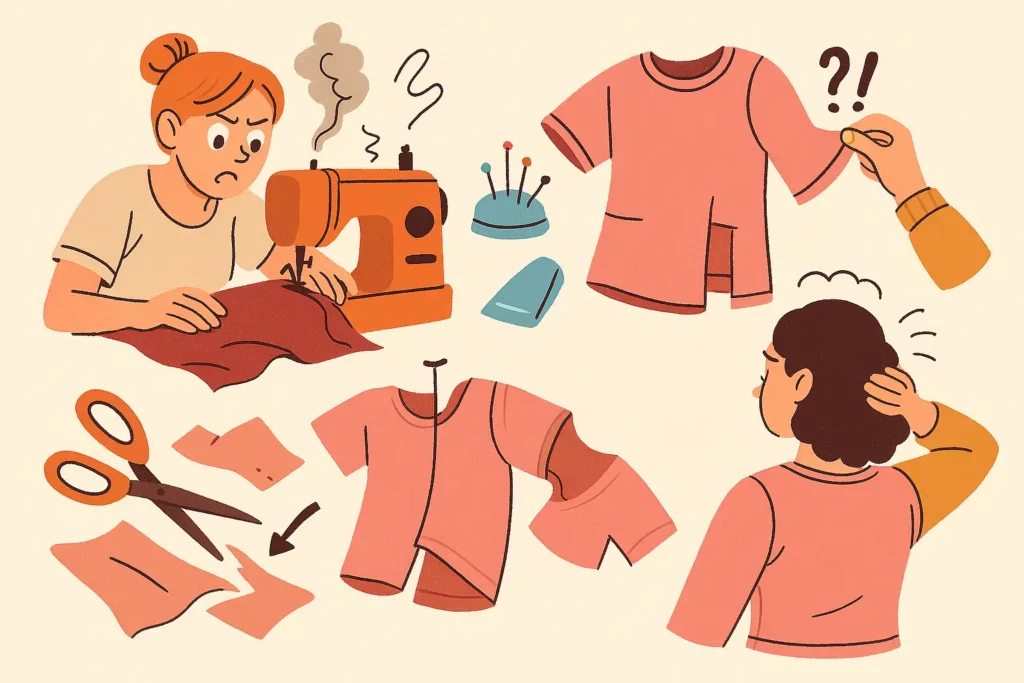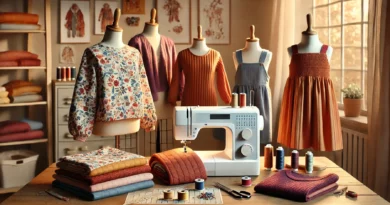
The most common sewing mistakes and how to avoid them?
Sewing wrong sides together, confusing right and left… When you’re new to sewing, you tend to make a lot of little careless mistakes, which can be very frustrating.
Here are 7 tips to help you stop getting worked up in front of your sewing machine!
Start with a pattern that’s too complicated
When we start sewing, we tend to want to make a pretty piece, without necessarily paying attention to the difficulty of the pattern. This is one of the most common mistakes, often resulting in a waste of fabric and a good dose of discouragement.
Try to start with an easy garment, which will enable you to get to grips with the main stages of production, from cutting the fabric to the small finishing touches. You’ll be pleased with your work and want to continue.
Each pattern indicates the level of sewing required: beginner/intermediate/expert.
Cutting and preparing fabric incorrectly
Cutting pattern and fabric are rarely the favorite steps for seamstresses and dressmakers. It’s a bit tedious, but you have to go through it to get a nice handmade garment.
When you’re just starting out, you may be tempted to skip this step to get to the sewing faster, which can have unfortunate consequences.
To remedy this, take the time to lay the pattern pieces on the fabric, respecting the straight thread, and pin carefully before cutting.
Also pay close attention to the seam allowances: they may need to be added when cutting the fabric.
Then transfer all the instructions from the pattern and mark the part number with a suitable piece of chalk. This can help you avoid confusing two similar pieces!
Confusing right sides with left sides
One of the challenges when starting out in sewing is to make sure you don’t make a mistake between right sides and wrong sides. Printed fabrics are no problem, since right sides and wrong sides are different.
But when sewing a plain fabric, it’s not uncommon to confuse and assemble the pieces in the same direction.
To avoid this problem, mark the right and wrong sides of your fabric with a small symbol that you trace with tailor’s chalk.
Sew right sides together
When assembling two pattern pieces together, the instructions will tell you to sew right sides together or, more rarely, wrong sides together. Whether you’re a beginner or not, you may find yourself sewing right sides together and needing to use the quick-discoverer to fix your mistake.
To avoid these careless mistakes, always remember to reread each explanation twice. Also, try to take breaks while sewing, and resist the urge to finish your piece as quickly as possible.
In the same vein, we sometimes inadvertently sew on a layer of fabric that doesn’t belong there. This happens, for example, when sewing the sleeves or collar of a garment.
To avoid being fooled, it’s always a good idea to keep any stray parts out of the way. You can also pin them in place so they don’t get in the way during assembly.
Don’t read instructions all the way through
Failure to read the instructions all the way through can lead to minor errors. As with cooking recipes, it’s always a good idea to read every step of the pattern before you start!
Ideally, before you even start your project, reading the entire step-by-step guide will help you anticipate problems. And it also allows you to start thinking about how to avoid them.
Do not iron as you go along
Explanations of sewing patterns often indicate to flatten or press a seam, or even to tuck the seam allowance towards the back or front of the garment. When you’re just starting out, you may forget this step, thinking it’s optional. Or preferring to leave your iron in the cupboard…
But ironing is very important when sewing! Flattening as you go ensures a beautiful, clean finish.
So never hesitate to keep your iron and ironing board close at hand.
Not sewing the right size
What could be worse than realizing that your garment is too small when you put it on? To avoid this disappointment, always take your measurements carefully and compare them with those of the pattern you’re going to use.
And not all brands cut the same way!
What mistakes do you frequently make, and what have you put in place to avoid them?



